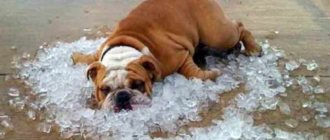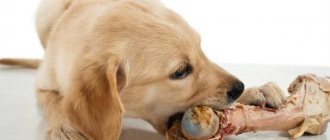Cryptorchidism in dogs is a dangerous disease that mainly affects puppies. In dogs, the testes are initially located in the abdominal cavity and as soon as the embryo begins to mature, they descend into the scrotum, following the inguinal canal. This occurs approximately on the 10th day after birth. And if both testes do not enter the scrotum, this is considered cryptorchidism. Unfortunately, many pets suffer from this disease. Research shows that of all puppies born, there is a 0.4% chance of having this condition.
Symptoms of the disease
Before starting treatment in dogs, it is necessary to understand the nature of this disease. And first, dog owners should know that false cryptorchidism exists. This is when the puppy is scared of something, nervous or too excited, then the testicles can simply go into the inguinal canal.
This occurs in puppies that are not yet six months old. And this happens because the ligament on which the testes are located is very plastic. And therefore, it can shrink from any impact, like plasticine. In this case, veterinarians recommend waiting 6–7 months, and only then sounding the alarm if the symptoms are confirmed. Since at this age the inguinal canal is completely blocked and the testes should already be completely in the scrotum.
There are also cases that in an adult male dog, due to some unexplained reasons, the inguinal canal does not close and the testicular ligament still retains its elasticity. If there is nothing in the scrotum, then it is cryptorchidism. The problem with the disease is that this disease is inherited. And if it was detected in one of the purebred puppies, then he is not allowed to mate. But, if the problem can be cured using gentle methods, the dog remains able to mate.
Consequences of the disease in the future
The disease can be successfully treated if it is detected in a timely manner. The duration of the pathology increases the likelihood of serious complications and the inability to correct the situation even surgically:
- if the testis is outside the scrotum for a long time, it decreases in size, making surgical intervention impractical;
- the disease leads to the gradual development of neoplastic or degenerative processes, which makes it impossible to reduce the testicle by any method;
- development of oncological tumors;
- the need for castration.
The disease is treated surgically
Testicular tissue that is located outside the scrotum greatly increases a dog's risk of developing cancerous tumors. In most cases, with an abnormal location of the testes, types of tumors such as teratomas, sertoliomas and seminomas appear. They are malignant in nature and characterized by rapid and aggressive development. They very often give metastases to neighboring internal organs - lymph nodes, prostate gland, organs that are located in the pelvic cavity.
In the early stages of cancer, there are no obvious signs. The disease is detected when the chances of a successful outcome from its treatment are negligible.
Note! Surgical intervention does not always make it possible to return the testis to its normal location. In this case, to keep the pet healthy, the only effective method is castration.
A dog's health depends on its owner
Undescended testes in dogs are a fairly common anomaly that can lead to very serious consequences. An animal that has been diagnosed with this pathology is never allowed to be bred, since the disease is highly likely to be passed on to offspring. Treatment requires conservative or surgical. The consequences of the disease are the development of cancerous tumors, degenerative processes in the testes.
Causes of the disease
The answer to the question: what is cryptorchidism in dogs? Any veterinarian will begin with the causes of this disease, and only then will he answer that, regardless of the causes, a distinction is made between embryonic cryptorchidism and postembryonic cryptorchidism. Depending on the stage at which the disease began to develop, you should start. And the nature of the disease directly depends on the following factors.
Anatomical features arise during the formation of the dog’s body. In this case, the spermatic cord and inguinal canal are too narrow to allow the testes to pass through. Disruption of the congenital folds at the base of the scrotum may also occur. There may also be very large testes in relation to the inguinal canal and an underdeveloped scrotum. Mechanical damage can cause a slowdown or inhibit the process of testicular descent.
Infectious diseases are often the cause of inflammatory processes in the genitourinary system. This greatly affects the development of the testes and serves as an obstacle to passage through the inguinal canal.
Hormonal disorders appear as a result of a lack of male hormones gonadotropin and testosterone (this disorder occurs during embryo development). This pathology becomes a problem and leads to incomplete contraction of the ligament.
Reviews
Irina, 37 years old, Krasnodar
“I have a Yorkie, unilateral cryptorchid. We went to the doctor when it was still 4 months, the doctor said to wait until 6. If this happens, he will refer me for surgery and we will suture the testicle to the scrotum. As agreed, we showed our Caesar at 6 months, and the veterinarian advised us to wait another two months or, even better, up to a year. We waited and hoped that it would go down on its own. Alas. As a result, we were prescribed to inject Gonadotropin and repeat it in the future (after 6 weeks). The canals can still be stimulated and the testicle will come out. We are waiting for the results.”
Olga, 29 years old, Moscow
“My pug has been suffering from cryptorchidism for 3 years now and his testicle can’t even be felt. The veterinarian advises castration, but so far they have refused. The dog feels good, no complaints. Once every six months we undergo an ultrasound and examine him to catch the tumor. I think we’ll take you to surgery when you’re 5 years old.”
What types of disease are there?
The following types of cryptorchidism are distinguished in puppies:
- a congenital species that developed during the embryonic period;
- an acquired appearance that appeared due to some external factors (for example, illness or physical injury);
- bilateral view, when not descended, both testes;
- monolateral type, when one of the testes has not descended (this is unilateral cryptorchidism in dogs);
- intra-abdominal – this is the abdominal type of the disease;
- true - this is when the testis is located in the upper or lower part of the scrotum and cannot descend to the end;
- raised testis - this symptom occurs when the growth of the spermatic cord is simply inhibited, when the testicle has already descended into the scrotum and the testis begins to rise again;
Classification of testes by palpation
- Retractile. The testes are located at the top of the scrotum and are constantly pulled up due to the fact that the muscle that elevates the testis is overactive.
- Ectopic. They can be found in places that are not typical for the testis.
- Undescended. These include absolutely all testes that are not located in the scrotum (exceptions are retractile and ectopic).
Classification of testes according to the type of non-palpable species:
- Canalicular. They may be located in the inguinal canal and cannot be palpated.
- Intra-abdominal. Found in the abdominal cavity.
- Developing. These are those types of testes that have not developed and because of this cannot be identified physically.
- Absent. Atrophied or agenesis testes (i.e. their complete absence).
Diagnosis of the disease
Experienced dog breeders recommend not searching on the Internet for an answer to the question: “what is cryptorchid in dogs,” but rather contacting a veterinary clinic to have your puppy diagnosed for the disease.
Anamnesis. First of all, the veterinary clinic collects all the necessary data. To accurately determine the diagnosis, you need a medical history. Therefore, the doctor must observe the location of the testes over time.
Inspection. The puppy must be examined in its natural environment so that the animal does not become nervous. Therefore, if going to the clinic is stressful for him, examining the retractile testis will be very difficult. It would be best to examine the development of the scrotum from the side where the testis is most likely absent.
Palpation. This is one of the most accurate methods for diagnosing the disease. And to do this, you first need to check whether there is a testis in the scrotum. And then you need to palpate the places from the inguinal canal to the scrotum. And if the testis ends up in the inguinal canal, they immediately try to artificially lower it into the scrotum.
Ultrasound. When palpation methods do not work. This method is questionable, but there is still some chance of detecting the problem. And it is done exclusively in a veterinary clinic.
Studying testosterone levels using gonadotropin. In this case, the dog's testosterone level is measured before the gonadotropin injection and one hour after the injection. And if after the injection the testosterone level is elevated, then the pet has cryptorchidism.
Laparoscopy is considered the most accurate method for detecting cryptorchidism in dogs. An endoscope is inserted into the abdominal cavity, which examines the inguinal canal for the presence (or absence) of testes.
General information: structure of eggs in dogs
Cryptorchid cat: what is it, castration for cryptorchidism
The size of eggs in dogs depends on the physical parameters of each animal. The testis is located in a suspended state on the spermatic cord, which is connected to the appendage. The epididymis, in turn, is connected to the excretory duct, in which mature sperm accumulate.
The appendages and testes are located in the scrotum. It is a protrusion on the abdominal wall. Consists of the same layers as the abdominal cavity. The sweat and sebaceous glands are located on the scrotum.
The presence of a large number of sweat glands and blood vessels in the scrotum helps maintain a stable temperature in it, several degrees lower than in the peritoneum.
Treatment
There are several types of treatment for this disease, and the methods depend on the severity of the disease.
The therapeutic method of treatment is based on the effect on the dog’s body. And for this, the pet is prescribed massage and hormone therapy. It is best to start treatment at the age of 6 – 7 months. Then there is a greater chance that the testes will be able to fall into place. Because when the inguinal canal is closed, the chances of success are reduced. Massage also helps if the testis itself can be felt. But if it is not felt, then other methods must be used.
Hormone therapy is prescribed when the level of male hormones in a male dog is low. The drugs provoke the production of luteotropic hormone, which affects the descent of the testicle. But, if the problem lies in other reasons, then this method is ineffective.
Orchiopexy is a surgical operation in which the testis is retracted down and secured in the scrotum artificially. In practice, this method is tantamount to castration, since it is very traumatic. This is interference with natural processes that can cause complications. The body can then experience severe stress. Therefore, in many countries, including Russia, this operation is prohibited.
Castration is an operation to remove the testes. Unlike the previous method, this approach is considered more humane and practical. But castration is the last method in treating this disease. Roughly speaking, if nothing else helps, or the disease has become advanced, the veterinarian may prescribe such an operation. And it is done under general anesthesia, where sedatives and painkillers are used. In this case, the operation itself may have several options. It all depends on the type of disease.
Conclusion
When a diagnosis of cryptorchidism is made and surgical treatment of this pathology is performed, both castration and orchiopexy are possible. In terms of trauma, anesthetic risk and postoperative care, these surgical interventions are identical.
It is imperative to educate owners about the various treatment options for cryptorchidism. If it is possible to preserve a functioning organ and the owners of the animal do not plan castration, then orchiopexy is the optimal method of choosing treatment. In case of complete or partial loss of the testis, they resort to prosthetic artificial testis.
Stages of the operation
- First, the doctor examines the animal.
- The next step is to get tested to prevent the risk of negative consequences from anesthetics. A blood test is done, as well as a biochemical analysis if the animal is healthy. And urine, X-ray, EchoCG, biochemical blood test, OBC - for sick animals.
- The puppy must be vaccinated 20-30 days before surgery.
- Deworming should also be carried out 10 to 14 days before vaccination.
- The pet must be washed the day before surgery.
- And for 10 - 12 hours, the dog must be on a strict diet and reduced fluid intake for 6 hours.
After the operation, the dog is admitted to the hospital, where it regains consciousness. This takes from 30 minutes to 2 hours. It all depends on how powerful the anesthesia was, what drugs were used on the dog, etc. It can take 6 to 12 hours for the medications to completely leave the body.
During this rehabilitation period, you can leave the dog in the hospital, but usually this is not necessary. You can also take care of your pet at home. And for this it is necessary to treat the sutures with antiseptic substances 1 – 2 times a day (for each case, the veterinarian prescribes different drugs). If necessary, the doctor may prescribe antibacterial agents and painkillers. To prevent your dog from licking or untying the seams, you need to wear an Elizabethan collar. The sutures are removed by a veterinarian 10–14 days after surgery.
Consequences of the disease
If the owner starts cryptorchidism in dogs, the consequences can be very sad. The disease should be diagnosed and treatment should begin at 6–7 months from birth. Then the inguinal canal is not yet closed and the testes can be lowered into place with minimal risk for the dog. But if the disease is neglected, then the failed testes in the scrotum can cause a malignant tumor. This will become a real problem, since even castration will not save the dog.
Forecast
Usually the disease is cured quickly and no complications arise. After three weeks, the animal recovers and can return to its usual routine.
In some cases, complications are possible, but they occur rarely and are associated with the characteristics of the body or disturbances during the procedures (for example, contamination of the suture).
It is important to monitor your pet not only in connection with sterilization, but also at the slightest suspicion of a disease. It can affect more than one offspring, so why not just monitor the pet and provide the necessary assistance in a timely manner. With constant monitoring and care of the dog, no problems will arise.
Disease prevention
Despite the fact that this problem affects male puppies, the disease can only be prevented when their mother is pregnant. And for this, the expectant mother needs to be given a balanced diet, a normal content of all vitamins and microelements. Avoid any medications and monitor your dog’s health.
Newborn puppies also need care. To prevent inflammatory processes from developing, you need to provide them with warm bedding (preferably heated). And during feeding, it is best to walk the bitch alone to eliminate the risk of contracting viral diseases. It is necessary to ensure that puppies do not develop injuries in the groin area, and begin treatment while the disease is in its early stages.
Cryptorchidism in dogs is a very unpleasant disease. And the biggest problem is that a puppy who suffers from this disease can pass this disease on to the next generation. Therefore, the dog has to be neutered. It is best to identify this disease at an early age in order to treat it with therapeutic methods.
Currently reading:
- Recommendations for obedience of a dog if it growls
- Causes of kidney stones in dogs and methods of treatment
- Ways to manage parvovirus infection in dogs
- Thyroid dysfunction in dogs (hypothyroidism)
Preventive measures
Preventive measures to prevent a dangerous genetic disease are:
- purchasing a puppy from a responsible breeder who monitors the health of the dogs before mating;
- caring for a pregnant bitch: balanced nutrition, limiting contact with other animals, especially untested ones; taking medications only after consultation with a veterinarian and assessing the risk to the offspring;
- caring for puppies with a balanced diet, eliminating stress.
If there are any deviations in the pet’s health, you should visit a veterinary clinic specialist for a thorough examination of the pet and discuss all possible ways to treat the animal with prognoses for a favorable outcome of therapy or surgery.
Only the owner’s love and attention to the pet will help him overcome the illness and subsequently delight the owner with activity and cheerfulness.
Source: www.belanta.vet











